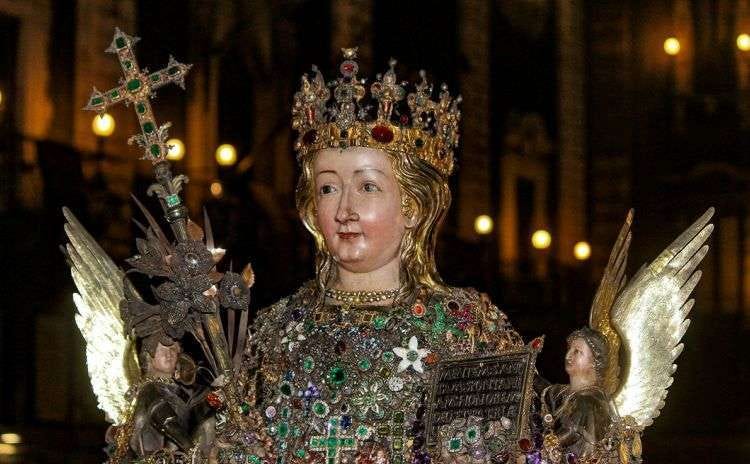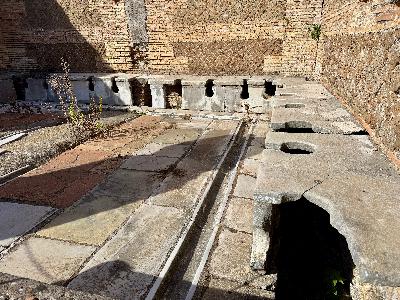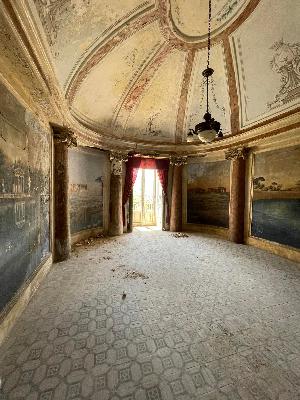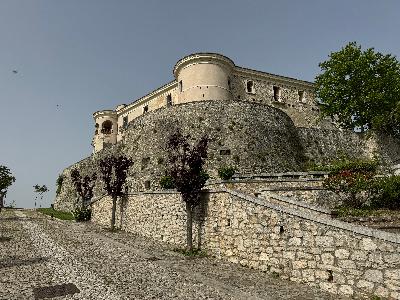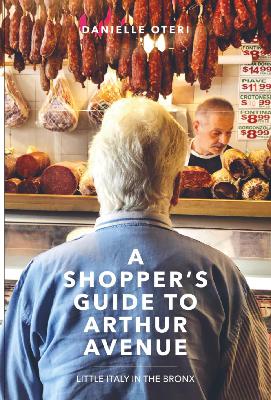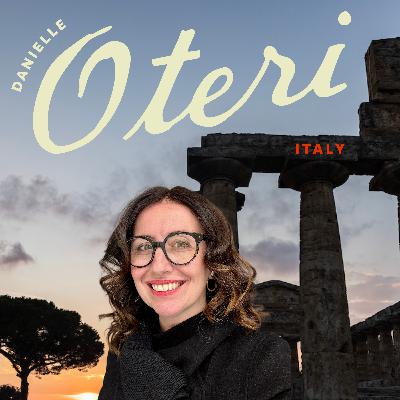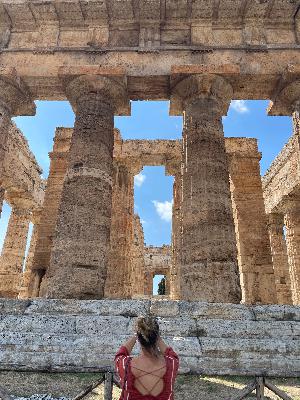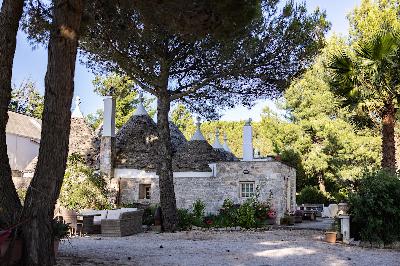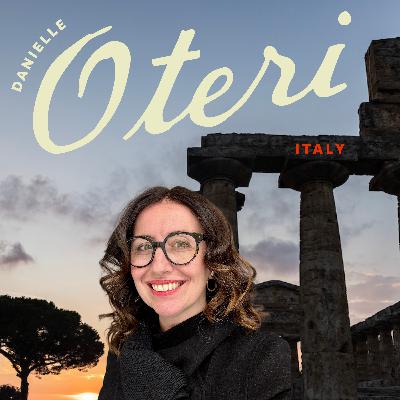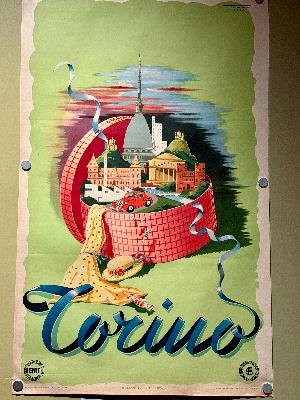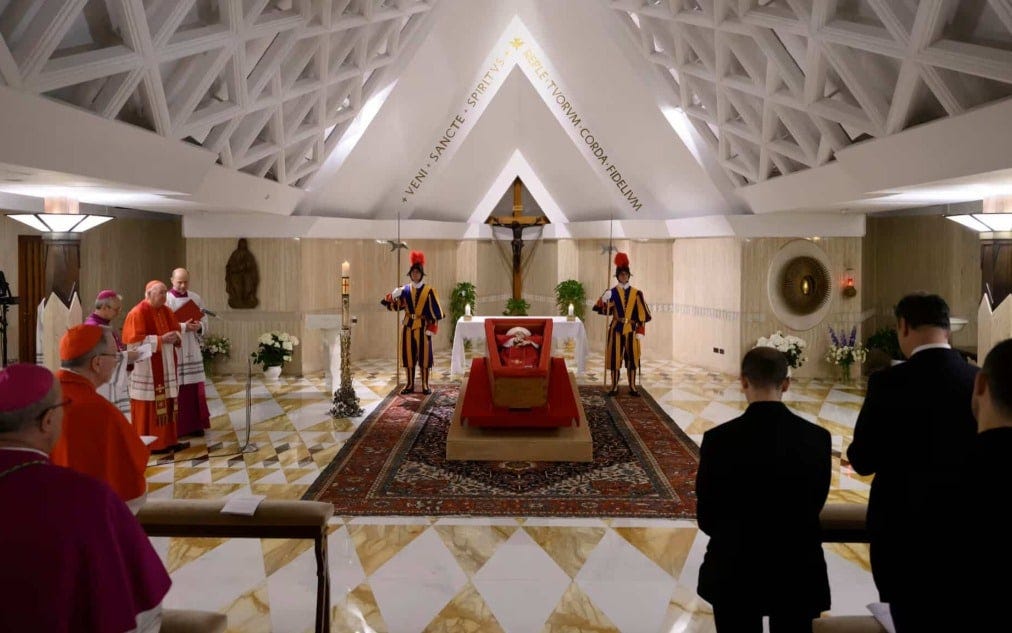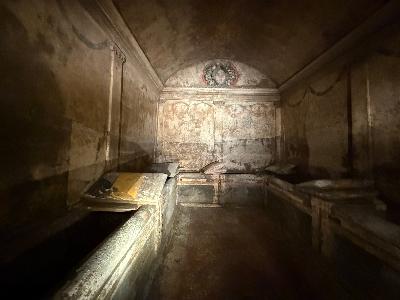Discover Danielle Oteri's Italy
Danielle Oteri's Italy

Danielle Oteri's Italy
Author: Danielle Oteri
Subscribed: 4Played: 11Subscribe
Share
© Danielle Oteri
Description
Discover the best of authentic Italy with travel expert and art historian Danielle Oteri. Each episode delivers inspiring stories and practical tips to help you confidently plan your next Italian adventure, covering art, archaeology, culture, food, wine, and history. Listeners get trusted recommendations and insider insights that unlock unforgettable experiences across Italy.
www.danielleoteri.com
www.danielleoteri.com
35 Episodes
Reverse
In this episode, I explore the phenomenon of “collective effervescence,” a term coined by the sociologist Émile Durkheim to describe the intense, shared emotional experiences that make us feel briefly part of something bigger than ourselves.Please support my work by taking out a premium subscription (just $8 per month).From saint processions in Ischia to bonfire rituals in Abruzzo and the miracle of San Gennaro’s blood in Naples, I explore how Italy’s festas and sagre are a kind of emotional infrastructure—places where community, memory, and the sacred all converge. I’m joined by writer and festival researcher Katerina Ferrara, whose regional guides help travelers weave these events into their itineraries.Together we discuss:* How festivals in Italy layer pre‑Christian rites, Catholic devotion, and modern life* Why small‑town saint days and harvest feasts are often the most powerful travel experiences* The role of children and returning emigrants in keeping these traditions alive* Catania’s identity as “the Black City” under Mount Etna* The story and cult of Sant’Agata, patron saint of Catania and of women with breast cancer* What actually happens during the three‑day February feast of Sant’Agata* The emotional “wave” when the saint’s statue leaves the church, and the crowd erupts* Festival foods you can only find on these days, including Minne di Sant’Agata and local arancine* Practical tips for tracking down festivals and sagre when dates shift every yearI want to thank my paid subscribers, who I hope are enjoying our monthly Q&A Zoom meetings and Destination Deep Dives. So far, we’ve explored Florence, Matera, Naples, and Rome. Next up: Venice and the Amalfi Coast.And since trip planning season is nearly here, I’ve refreshed my menu of trip planning services. From one-hour Trip Consultations to hybrid Custom Itinerary Design or full Bespoke Trip Planning, everything is explained there so you can choose the option that best fits your needs and budget.Chapters/timestamps00:00 – What is “collective effervescence”?02:00 – Why Italian saint festivals feel so powerful05:00 – Bonfires, solstices, and ancient roots of Italian rituals08:00 – Meet Katerina Ferrara and her festival guides11:00 – How to actually find and plan for festivals and sagre15:00 – Food festivals, fundraising, and “festifusion”19:00 – The Infiorata of Noto: a two‑day flower masterpiece24:00 – Children, memory, and passing traditions on28:00 – Catania and the Val di Noto: baroque cities under Etna32:00 – The legend and martyrdom of Sant’Agata36:00 – Inside Sant’Agata’s three‑day feast and all‑night procession43:00 – Devotion, identity, and the bond with a patron saint47:00 – Festival sweets: Minne di Sant’Agata and more51:00 – Catania’s unique arancine and horse‑meat culture54:00 – How to follow Katerina and use her guidesGuestKaterina Ferrara – Author of regional festival and sagra guides for Sicily, Puglia, Rome & Lazio, and Venice & the Veneto. She helps travelers anchor their trips around local celebrations.* Website: katerinaferrara.com* Instagram: @katerinaferrara_author This is a public episode. If you'd like to discuss this with other subscribers or get access to bonus episodes, visit www.danielleoteri.com/subscribe
In this episode, I explain the differences between travel agents, advisors, and influencers…because I know first-hand how confusing this world can be!You’ll hear industry insider stories, plus the simple method I give people to decide when to DIY their trip, when to get professional help, and when to trust their own gut over another influencer’s feed. I’ll also share unglamorous but essential tips picked up over the years on the road—like the realities of country driving in Tuscany or the best place to stop for gas on your way to Naples airport.You’ll also meet my new collaborator, Angela Miklos, whom I first met in 2023 as a Trip Consultation client and who will now help me offer a brand-new hybrid service called Custom Itinerary Design. (The photo in your podcast player is the classic Forio sunset that Angela mentions.) This option is for people who love research and planning but want an expert to provide the best advice and handle the heavy lifting so that they can focus on the fun parts.A reminder for paid subscribers that the next Ask Me Anything About Italy is on December 11th at 8 pm ET on Zoom, and the Venice Destination Deep Dive happens on December 18th at 8 pm ET. Right now, both the Naples and Rome Destination Deep Dives are available to watch for paid subscribers. They’ll leave the website soon when the polished, final versions with the itinerary and bonus segments are ready for purchase. (Naples leaves in a week, Rome will be up for at least 2 weeks more.) This is a public episode. If you'd like to discuss this with other subscribers or get access to bonus episodes, visit www.danielleoteri.com/subscribe
I’m back from my research trip and have so many interesting things to share with you. Before I tell you all about Ostia, here’s a reminder for my paid subscribers that Thursday November 13th is the next “Ask Me Anything about Italy.” It’s happening at 8:00 p.m. ET on Zoom, and if you can’t make it, please send me an email with your question. I’ll answer it live, and then you can watch the replay the following morning.Then, on November 20th, I’ll be premiering the next Destination Deep Dive on Rome. I spent 5 days in Rome just to research this Deep Dive. Here’s how it works. If you’re a paid subscriber, you’re invited to the live premiere on Zoom. It will be available to paid subscribers until I finalize the version, which will then be made available for sale along with a complete itinerary and bonus resources. And paid subscribers get a 50% discount.Last Sunday, I was wandering around Ostia Antica, desperately searching for the restroom. Not the modern one, which was located right next to the entrance of the archaeological park, but the ancient one, where Romans would take care of their essential personal business sitting, uh… cheek to cheek.The communal toilets are the most famous thing in Ostia, but they aren’t marked on the map or any of the signage. I knew they were part of the bath complex that was adjacent to the forum. Today, the ancient city of Ostia is located near the airport, but 2,000 years ago, it was also an industrial hub where goods came in and out, due to its strategic position where the Tiber River meets the sea. The experience is similar to Pompeii, but Ostia wasn’t buried by a volcanic eruption; instead, it sank into the silt and turned into a swamp fiercely guarded by malaria-carrying mosquitoes until it was reclaimed in the 1940s. Today, it’s a well-tended but little-visited archaeological site. It’s easy to reach from the center of Rome, and easier to traverse than Pompeii, with lots of spots to sit on ancient stone beneath lush umbrella pines that stretch their lush branches in all directions like they slept late and just got out of bed.After winding my way through the Forum baths, the gym, the hot room, and the cold room, I found the famous toilets. The engineering is all exposed, including a channel where water would constantly flow to flush away waste. The openings in the marble bench where people sat are about as close to each other as the indents on the New York City subway. Being shocked at the lack of privacy is not something most people, throughout most of human history, would have even noticed. Today we are awash in privacy and convenience that we take entirely for granted. And while the pleasures of indoor plumbing, kitchens, washing machines, and air conditioning eliminate much of the drudgery of life, these conveniences have fundamentally reshaped our society. The more privacy we enjoy, the less we need the public square and each other.I always discourage people from taking a day trip to Pompeii in favor of a much easier trip to Ostia Antica. While yes, it’s possible to take the fast train, and there are lots of bus tours offering this, it’s a very long and expensive day of getting there and back for what is necessarily a swift and shallow experience of Pompeii, which deserves a good, long visit. Ostia Antica offers the same experience, allowing you to walk through a Roman city along the same roads as everyday citizens, past their homes, shops, and public buildings.Also, it’s so peaceful. Even though it’s extremely easy to get there, just $3.50 on the very pleasant Metromare train, only the most interested travelers go there, along with school groups, so you can take your time gazing at the mosaics of sea horses and the gods of the sea in what were the baths of Nerone. You can explore a thermopolium, a typical Roman quick-service restaurant, as only the wealthiest Romans had kitchens, and enslaved people to prepare meals for them at home. There’s a theater, a district of warehouses, as this was a port town where the work of shipping across the Roman Empire was done, and the oldest known synagogue in Europe. Just outside the archaeological park is a castle and a cobblestoned district of restaurants where you can eat very well. Or go one more stop on the train, or grab a quick taxi ride to be right on the beach and enjoy a perfect dish of spaghetti and clams for lunch.Ostia Antica was diverse, like most Roman cities. As armies conquered lands across Europe, North Africa, and the Middle East, people captured as slaves during wars across the empire were brought back as war booty and put to work. There were also the indigenous people who had founded cities, including Pompeii, before the Romans took over. They continued to speak their own languages and imparted many of their customs to the Romans, which have been passed down to us today without the appropriate label.Life for most Romans was extremely public. Homes weren’t much more than places to sleep. The baths were places to work out, get clean, and, most of all, socialize, and all levels of society would encounter each other at the baths. And everyone, even the wealthy, would eat at the many fast food restaurants you find in every Roman city. Studies by bioarchaeologists at Pompeii have discovered that all Romans, regardless of social class, ate the same fish, grains, and meats; the primary differences were the settings in which meals were served. They would have to to public fountains for their drinking water. Everyone in a Roman city had to do their laundry, and would take their clothes and blankets to storefront laundries. The Forum was always the center of the city, with all the administrative bodies in place, as well as a large communal piazza where crowds could gather.Only the wealthy enjoyed privacy, albeit minimal by modern standards. Walking around Ostia or Pompeii, you will see wealthy homes tucked right into the urban grid next to modest or even poor homes where enslaved people resided. The larger villas were situated on the periphery of the city, offering sea views or surrounded by orchards or woods, but access to the city remained important. Even at a massive villa like Villa Oplontis, which belonged to someone of the highest Imperial class, close to Pompeii, the guest rooms that orbit the infinity pool are small, indicating they were really just for sleeping. Most of the time spent in the villa would be in the company of everyone else who lived there. And there was a working warehouse directly next to it, because showing your industriousness was a prime virtue in Roman society.Jonathan Haidt, author of “The Anxious Generation,” frequently cites the research of Robert Putnam, which demonstrates how a major turning point in American culture during the 1990s, when people began distrusting their neighbors, was due to the widespread adoption of central air conditioning. Previously, few households had more than one air conditioner, which they would use only on the hottest days, and so people spent far more time outside with their neighbors. Television and cars in the 1950s, and then air conditioning in the 1990s, directly led to a steep decline in community engagement.A few days earlier, when I was in Pompeii, I overheard a tour guide explaining why there were so many bath complexes among the ruins. The American guests thought it was odd that there were so many people indulging in a spa experience until she explained that Roman homes, except for the most luxurious ones, did not have either bathrooms or kitchens, and that almost nothing about daily life was private. If you were very rich and had lots of slaves to fetch things for you, he went on to say, you might have a house that was closer to the sea. The guest responded by telling the guide how he had recently bought a house in Florida. I guess he was trying to relate to the history being explained, but missed the mark.There are many inaccurate stereotypes about the Italian dolce vita, but one thing that stands is the tighter social fabric, at least compared to life in North America. I remember going to a movie theater in Florence on a Tuesday night and choosing seats in the empty theater right in the middle. Maybe only 20 other people trickled in and sat immediately next to us, which I thought was odd, until I realized that was my American instinct to spread out away from others. Look at a Roman city, or an Italian village clustered on a hilltop. Social cohesion requires proximity. And Italy is still light on air conditioning, as HVAC units have become much more energy efficient, and European summers get hotter and hotter. If air conditioning is more widely adopted in Italy, will it erase the culture of the piazza?The lesson is that social cohesion thrives when life is less convenient. The Roman Empire still fell, there were still terrible wars, and despots and dictators, but I believe the underpinning of the Italian way of life lies in communal experiences. The communal bread ovens you can still find in small villages, the trattorias that serve local dishes, even if they seem repetitive, which I hear travelers sometimes lament. Those dishes are anchors, and when you visit Italy, you should try to eat the most local things possible. I flinch when I see prices rising because I know young Italians enjoy a level of sociability that is so much better than in the U.S., because a spritz and a pizza are generally inexpensive.Walking around a city like Ostia Antica is an opportunity to reflect on daily life, past and present, not just the wars and conquests of history. I get something different every time I visit an archaeological site. This time, I’m contemplating how convenience should not always be a top priority. And for people who want a deeper experience of Italy, consider sacrificing a bit of comfort sometimes, such as going off the beaten path, to experience the power of connection. I’m receiving numerous emails about trip planning for 2026, and I’d like to share
Paid subscribers, tonight is the premiere of the Naples Destination Deep Dive! See you at 8 pm ET. The replay will be sent out tomorrow and will be available until Monday. The Zoom link was sent last week and will be posted again in the subscriber chat.This week I have a quick video episode to share with you some of my new programs for 2026.I share that I have developed four hybrid experiences, all during the quieter off-season, in Florence, Naples, Venice, and Rome.* One guided tour each day, so you get to see the good stuff with the smartest guides, without feeling over-programmed.* Four shared group meals—think real conversations at local favorites. We’ll talk about books, politics, truth, beauty, and all the things we’re discovering in the city when we’re not together.* Pay only for your time with me and what’s included: the tours, entrance tickets, and the four shared meals.* Freedom to choose your own lodging, whether that’s an Airbnb, a five-star, or use the Marriott Bonvoy points burning a hole in your pocket. Stay wherever best suits your budget and vibe.* No single supplements or “forced group activities.” Bring a partner or friend, and let them do their own thing while you spend time with us. (Perfect if you have a cranky spouse.)Each city’s experience is built around what I think makes it unique:* 5 Days in Florence, January 20-25: All about art. We’ll be at the Fra Angelico exhibition during its final week and dig deep into Renaissance masterpieces.* 5 Days in Naples, January 27-31: A journey from ancient times to today, including a special day trip to Herculaneum and Villa Oplontis. The intensity of a city positioned between two active super volcanoes without the heat. Be sure to read some Elena Ferrante before the trip.* 5 Days in Venice, October 27th-31: Venice is a fever dream, and I’m designing this itinerary to draw out its inherent magic. This is Venice for people who hate selfies.* 5 Days in Rome, November 3-7: More focused, for travelers who love art with a dramatic edge. Caravaggio, Baroque drama, and all the classic Roman dishes.I’m also excited to share the dates for the next artist retreat with Jenny Kroik at Borgo La Pietraia. This will be the fourth time we host this special week focused on peace, calm, and the chance to reconnect with your creativity. Jenny welcomes everyone—total beginners, working artists, and anyone who just wants focused time to enjoy making art. Daily sessions are relaxed and supportive, with inspiration from the landscape, local food, and easy day trips. The only thing you need to bring is the desire to create and be inspired—no experience required.Also, this retreat has the best food ever. Chef Mario Stellato prepares most of our meals, and it is just BEYOND.If the idea of exploring Italy with structure but not rigidity appeals to you, I think you’ll find these trips hit the mark. You can look at all the trips here. This is a public episode. If you'd like to discuss this with other subscribers or get access to bonus episodes, visit www.danielleoteri.com/subscribe
Purchasing a home in Italy is a dream of many. In the 1990s, Tuscany was the most popular region, as well as a more affordable alternative to France, following the publication of the 1989 book “A Year in Provence,” which inspired the rustic farmhouse fantasy. Many British and American citizens began buying old farmhouses surrounded by cypress and olive trees, while in the US, people renovated their kitchens with a “Tuscan farmhouse” theme. Then came Frances Mayes’s memoir, “Under the Tuscan Sun,” which chronicled the complex but romantic work of renovating a house in Cortona, and an industry fully bloomed.Today, Italy’s hot spot for expats is Puglia. When Tuscany was taking off in the 90s, the region of Puglia was struggling even to welcome tourists, but all that has dramatically changed, and prices there have risen sharply. I regularly receive questions about where to find the best home-buying opportunities in Italy. (My answer: Le Marche, Abruzzo, and Cilento.) I can help you hone in on where to settle in Italy, thinking about lifestyle, access, and budget, but I know nothing about renovating a house. If I ever do buy a home in Italy, I will have a budget dedicated to hiring someone who has the skill and patience to navigate the commune for me, because permits and paperwork are not my thing.To offer you a more informed perspective, I interviewed Massoud Katebeh, a licensed engineer in both the United States and Italy. Originally from Tehran, he studied engineering at the University of Florence, where, like me as an art history student, he had the opportunity to study right inside the Duomo. We discuss the intersection of engineering and art, as well as the rigorous process of becoming a professional engineer in Italy.We then discuss the challenges of renovating homes in Italy, why it is necessary to engage professional architects and engineers, and what makes a home renovation project different in Italy than in the US. Finally, Massoud shares his thoughts on whether it’s best to buy a new home with all the modern conveniences built in, or take a chance on renovating an ancient structure.If you’d like to get in touch with Massoud for a nuts and bolts perspective on your Italian dream home, you can find him at mgkengineering.comThe Destination Deep Dive devoted to Florence is now available. It includes a 45-minute video that guides you through everything you need to know, including highlights, tourist traps, the best time of year to visit, what to see, where to eat, and where to take a day trip, as well as a detailed 5-day itinerary. You can easily modify this to suit your travel dates. If you want a well-researched and thoughtful trip but don’t have 30 hours of research time available, this is the shortcut. That’s about how much time it took me to put this together, and that doesn’t include the year I lived in Florence and many times I’ve returned since. There are also two bonus cheat sheets, one devoted to the foods of Florence – because it’s not the pizza and pasta people typically associate with Italian food – and a second dedicated to lesser-known sites where you can truly access the soul of the city.If you’re a paid subscriber, you are invited to the launch for each month’s destination deep dive for free, which includes a Q&A, and then later, when the presentation is formalized, along with a detailed itinerary and bonus content, you get 50% off. I’m about to publish the Matera Deep Dive, and on October 15th at 8 pm ET, I’ll be debuting the Naples Deep Dive. This is a public episode. If you'd like to discuss this with other subscribers or get access to bonus episodes, visit www.danielleoteri.com/subscribe
Let’s talk about how late 2025 is the perfect time to think about your trip, before you start planning it.A Rare Invitation: October 2025 Research TripBefore diving into my trip-planning strategy, I have something special to announce:Next month (yes, October!) I’m going on a research trip and I’d like to invite you to join me.* See the awe-inspiring temples of Paestum, where we will go deep into discussion rather than just “touring.” * Bake bread with Chef Mario Stellato and his grandmother.* Taste wine at my beloved Tempa di Zoe vineyard.* Geek out on medieval history with me in Salerno and go shopping.You can also extend the adventure with two nights in Matera and a final night in Naples. Because it’s last-minute and at the magical end-of-season pricing, this is an opportunity I cannot repeat in another season. There are 4–5 spots filled, and I’m capping at 10. All the details are here. Why You Should Dream NOW (Not Just Plan Later)So many clients arrive to me stressed and glazed over. They’re paralyzed by too much information, and the most challenging part of planning an Italy trip is knowing how to sift through it all, but I can help you.Why start now? Because dreaming early lets you clarify:* What do I want to FEEL on this trip? * What experiences genuinely matter most to me?* What can I afford to spend (and what’s realistic for 2026 Italy)?Starting with intention and honesty is the secret to coming home fulfilled instead of overwhelmed or overspent.Hard Truths: Logistics & Budget* Don’t overdo it: If you have 10 days, pick a maximum of three bases. Don’t be swayed by fast trains or bucket lists. Trenitalia won’t deliver you straight to the Amalfi Coast or Tuscan countryside—you’ll need transfers, ferry rides, or a car rental for rural adventures.* Timelines matter: The big cities (Rome, Florence, Venice) are best in the off-season (think February or early December). Prices drop and the crowds thin, which can be a dream for the right traveler.* Regional closures: Places like Amalfi and Puglia shut down after November 1st. Budget-wise, don’t assume Italy is the cheap-and-cheerful destination it was in the days of the lira. The cost has shifted—especially for Americans. Get clear on your comfort zone and be upfront about your priorities: a great trip can be planned on any budget if you’re realistic from the start.The Most Important Question: What Truly Inspires You?Everyone always skips this step, so let me insist:* Do you crave outdoor adventure?* Dream of sitting in a Roman piazza like a Ripley character?* Want to reconnect with family or celebrate a milestone?Clarifying how you want to feel will make all the difference.My Four-Ingredient Recipe for a Great Italian TripMix these in for the perfect adventure:* Plug In: See something iconic and take it in deeply—think Colosseum, Florence’s Duomo, or a UNESCO heritage marvel. * Unplug: Plan unstructured downtime—a wine tasting, a soak in thermal springs, or a two-hour people-watching session with a notebook in a piazza.* Indiana Jones Moments: Seek real adventure—ruins, archaeological wonders, challenging hikes, or a boat trip beneath ancient cliffs.* What You Love, Italian-Style: Bring your passion (cooking, fashion, sports, spirituality) and live it the Italian way for a fresh perspective.Two Final Notes: Budget & Flight MythsBe honest and up-front about your budget. Don’t feel guilty about your number—it’s your trip. Prioritize accordingly. If Venice is your dream, go all-in on one destination during the low season for a richer experience. It will likely be better than a three-city trip with a bigger budget.And on flights? When you find a fare you’re satisfied with, book it and move on with your life.For Paid Subscribers…Sept 11th at 8 pm ET, I’m offering a live Zoom Destination Deep Dive on Matera (with replay available for three days). Last month’s Florence Deep Dive, including a very detailed 5-day itinerary, is now available to purchase. This is a public episode. If you'd like to discuss this with other subscribers or get access to bonus episodes, visit www.danielleoteri.com/subscribe
This episode is about the magic of Fra Angelico, the Renaissance “angelic painter” behind Florence’s most tranquil and moving frescoes. I’m joined by historian Alexandra Lawrence, who shares the thrill of experiencing art in its original context, and what visitors can expect from Florence’s major fall exhibition at Palazzo Strozzi and San Marco.Plus: personal stories about being transformed by Italian art, teaching and learning through travel, and a candid conversation about the difference between Florence and Naples.* Here’s the link to join Heaven Bound: The Life and Art of Fra Angelico, Alexandra’s online course that starts on September 4th. * Subscribe to Alexandra’s newsletter Illuminare* Finally, are you planning a trip to Florence and want insight, not just information, plus a detailed itinerary that you can modify for your trip dates? Get my brand new Destination Deep Dive: Florence. This is a public episode. If you'd like to discuss this with other subscribers or get access to bonus episodes, visit www.danielleoteri.com/subscribe
Warning: this episode contains grisly descriptions of a historical double murder.Episode 25 looks at the brilliant and violent life of Carlo Gesualdo — the Renaissance prince who murdered his wife and her lover, then retreated to his castle in rural Southern Italy, where he wrote music and had himself flagellated, among many other strange activities. Although Gesualdo faced no legal punishment, his crimes haunted him and manifested in his music, which was both beautiful and weird, and wildly ahead of its time.This episode features my conversation with Michael Cirigliano II, author of the newsletter Shades of Blue, who explains how you can hear Gesualdo’s emotional breakdown in music that was also wildly innovative, it wouldn’t be fully appreciated for another 250 years.We also discuss:* The official report of the murders in Naples, the horrifying scene, and the eyewitness’s account of Gesualdo’s actions.* Gesualdo’s exile to his hilltop town of Gesualdo in Irpinia and the spooky, isolated life he led there.* The two creative periods in his output: the refined madrigals written in Ferrara at the Court of Este, and the sonically weird madrigals written at the end of his life.* Why twentieth-century composers like Stravinsky re-discovered him and why his music continues to fascinate performers and listeners.* How to travel to Gesualdo’s castle, and the Sansevero Chapel in Naples (home to the Veiled Christ) with Gesualdo’s music playing in your AirPods.I also discuss Werner Herzog’s absolutely bonkers 1990 documentary and how local lore and modern storytelling shape what we think we know about Gesualdo. The episode weaves music, travel, and history. And if you want to go deeper into Gesualdo’s life, Alex Ross’s article in The New Yorker is an exciting read and an excellent summation of decades of scholarship. Thanks to Michael, here is a concise listen to Gesualdo’s descent into genius and madness:I. An example of Gesualdo's early madrigals:Book 1: "Baci, soavi, e cari" (1594, written in Ferrara)* Text and translationII. Two examples of Gesualdo's late, chromatic, nightmarish madrigals:Book 6: "Moro, lasso, al mio duolo" (1611, written in Gesualdo)* Text and translationBook 6: "Beltà, poiché t'assenti" (1611, written in Gesualdo)* Text and translationIII. And an example of his rare foray into sacred music. Here, Gesualdo is more conservative in his writing, likely because he's seeking penitence and absolution (this was published shortly after he commissioned Il Perdono di Gesualdo)"O vos omnes," from Tenebrae Responsoria: Responsory at Matins for Holy Saturday (1611, written in Gesualdo)* Text and translationFinally, Michael and I reconnected after working on this essay about Manhattan Castles for the Metropolitan Museum of Art. Years later, I wrote this essay, which features Henryk Gorecki’s Symphony of Sorrowful Songs, which Michael explains here. If you enjoyed this episode, please consider becoming a subscriber. I want to continue creating episodes that can deepen your experience of Italy and provide you with stories that you can transform into your own travel adventures. They require lots of research and editing, and the more support I receive through subscriptions, the more I can offer. This is a public episode. If you'd like to discuss this with other subscribers or get access to bonus episodes, visit www.danielleoteri.com/subscribe
Upcoming Events for Paid Subscribers🗓️ Ask Me Anything About Italy – Wednesday, July 24 at 8 pm ET - The Zoom link will be sent to subscribers on Thursday afternoon!🗓️ Destination Deep Dive: Florence – Wednesday, July 31If you're a paid subscriber, you'll receive access to both Zoom events — ask your travel questions live on the 24th, and then join me for an immersive cultural deep dive into Florence, its Renaissance treasures, and its hidden gems on the 31st.💌 Not a paid subscriber yet? Subscribe here to unlock all Italy travel resources, including itineraries, deep dives, and replays.This week’s question comes from Kristin on Instagram, who asks, “What the heck is a UNESCO World Heritage Site?”Whenever I help someone plan their trip to Italy, I try to include what I call an Indiana Jones moment. This place invites a sense of wonder and curiosity, where history comes alive and you're completely immersed in the experience.One of the best places to look for ideas? Italy’s UNESCO World Heritage list.In this episode, I discuss the stories behind some of the most famous sites, including the historic centers of Rome and Florence, as well as lesser-known places like Matera, the Arab-Norman architecture in Palermo, and the monumental Certosa di Padula monastery in the Cilento.You'll hear why these sites matter, how they got their designation, and what happens after — including both the benefits and some of the criticisms of the UNESCO system. I also discuss what it means for travelers like us and how to find meaningful experiences, not just the Instagrammable ones.So if you're looking for inspiration — especially something a little more adventurous — this episode is a great starting point.00:00 - 02:00: Introduction to UNESCO and its role in preserving cultural heritage. 02:01 - 05:00: Italy's prominence with 59 UNESCO sites and what it means. 05:01 - 08:00: The transformation of Matera and its historical significance. 08:01 - 11:00: Discovering the Certosa di Padula and its architectural wonders. 11:01 - 14:00: The Arab-Norman cathedrals in Sicily and their cultural fusion. 14:01 - 17:00: The impact of UNESCO designation on tourism and preservation. 17:01 - 20:00: Tips for visiting and incorporating UNESCO sites into your itinerary. This is a public episode. If you'd like to discuss this with other subscribers or get access to bonus episodes, visit www.danielleoteri.com/subscribe
Subscribe to support this podcast and get access to exclusive monthly Zoom Q&As and Destination Deep Dives for just $8/month or $80/year at danielleoteri.com.This week, in honor of the 4th of July, I’m taking you to a piece of Italy in the United States—Little Italy in the Bronx, better known as Arthur Avenue. This episode also celebrates the publication of A Shopper’s Guide to Arthur Avenue, which I wrote to help you discover the best bites in each of the historic, family-run Italian food shops in Little Italy in the Bronx.My great-grandparents opened a baccalà shop there in 1918. Their son John took it over in 1950 and turned it into a butcher shop, which was also used for the opening scenes of Marty, which won the Academy Award for Best Picture in 1955. It remains a butcher shop today, now known as Vincent’s Meat Market. In 2010, I started Arthur Avenue Food Tours to help people experience the rich legacy of this unique neighborhood and help support and sustain this enclave of family-run food businesses. But as a historian, I was also curious to learn more about the origins of the neighborhood. The “official” story of Arthur Avenue’s foundation is that the area quickly became an Italian enclave after Catherine Lorillard Wolfe donated land to form what is now the New York Botanical Garden and also sold tracts of land to the city of New York. It was first published in a 1984 history book by the Bronx Historical Society that she had requested that the main thoroughfare be named after Chester A. Arthur, 21st President of the United States. Upon examining old maps, it was immediately clear that this story was false. The urban grid you see today was there as far back as the 1870s, and Arthur Avenue was named Arthur Street before Chester Allen Arthur was even born. Moreover, Catherine Lorillard Wolfe never owned any of this land, though ancestors who were not in her direct line of descent did own farmland in the area. The real founder of Little Italy in the Bronx was an Italian immigrant named Pietro Cinelli. He bought land, developed apartment houses, and petitioned the Archdiocese of New York for an Italian church. He also fought off threats from the Black Hand, a vicious criminal syndicate with its origins in Southern Italy that was the precursor to the Italian mafia that rose during and after World War II. The big question is this: Why was Pietro Cinelli written out of the official record? In this episode, I’ll share with you the story of his daughter’s kidnapping, and then invite you to help me figure out the larger mystery.00:00 Introduction to Little Italy in the Bronx00:37 The Historical Significance of Arthur Avenue05:36 The Mystery of Pietro Cinelli12:27 Uncovering the Truth Behind Arthur Avenue's History20:58 The Importance of Personal Stories in Immigration History—🛒 A Shopper’s Guide to Arthur Avenue is now available on Amazon🎧 Paid subscribers get full access to my travel deep dives, including this month’s focus on Florence📍 Subscribe at danielleoteri.com This is a public episode. If you'd like to discuss this with other subscribers or get access to bonus episodes, visit www.danielleoteri.com/subscribe
In this new Q&A episode, I answer three listener questions with the candidness you've come to expect from me. :)* You keep saying Cilento, but the rest of planet Earth says Amalfi. I believe you, but I’m not convinced. What’s the deal?(Let’s talk about commissionable networks, affiliate travel content, and why repetition creates false assurance.* My flight lands in the morning — should I plan something for that first day?(Short answer: no.) But I’ve got a surprising answer about what you should do.* What about renting a car, and is driving in Italy totally insane?(It depends on where you’re going.) Additionally, I share with you what you need to watch out for when driving in Italy, coming from someone who learned to drive from a New York City bus driver!You’ll also hear about this month’s Destination Deep Dive: Cilento, available for free now. Starting in July, Deep Dives will be available only to paid subscribers, beginning with Florence.👉 Support this work and get access to all Deep Dives by becoming a paid subscriber at danielleoteri.com🎙️ Have a question you’d like me to answer? Record a voice note on your phone (under 60 seconds) and email it to: danielle@feasttravel.com This is a public episode. If you'd like to discuss this with other subscribers or get access to bonus episodes, visit www.danielleoteri.com/subscribe
I’m thrilled to introduce the Destination Deep Dive — a live Zoom session where I will unfold one destination or itinerary in Italy.This isn’t a tidy region-by-region breakdown a la Stanley Tucci. (No offense to the Tooch, he’s great.) Instead, these are strategies for people like you who are planning meaningful trips that may include popular spots like Rome or Florence, but who want to go deeper and live their own story.Each session will discuss:* Why the destination is worthy of your time and money* What to see, eat, drink, and also what to skip* Lots of history and stories, as well as practical tips* A downloadable itinerary so you can make this trip your ownThis month’s session is free for all subscribers, and we’re starting in Cilento — my second home and one of Italy’s best unsung places. We’ll cover the temples of Paestum, the origins of the Mediterranean Diet, the Cilento Coast’s best villages and beaches, and where to find the most heavenly buffalo mozzarella.➡️ Join us live on Zoom or watch the replay, which will be sent out on June 20th.🗓️ Thursday, June 19th at 8 pm ET📍 Click for Zoom linkPaid subscribers will also receive a full itinerary after the session. Starting next month, these Deep Dives will be available only behind the paywall, so now’s a great time to upgrade if you’ve been thinking about it. As the archive grows, so does the value.Hope to see you there!Danielle This is a public episode. If you'd like to discuss this with other subscribers or get access to bonus episodes, visit www.danielleoteri.com/subscribe
Cooking classes are now on nearly every Italy itinerary—and for good reason. Food is one of the most intimate ways to understand Italy’s culture and traditions. But as tourism to Italy has exploded, so has the number of cooking classes—many of them aggressively mediocre experiences offering pizza, pasta, and gelato in every city.In this episode, I explore what it means to take a meaningful cooking class in Italy—one that connects you to a region’s real foodways, people, and stories. You’ll hear from two women who offer exactly that:Pamela Sheldon Johns has been living and cooking in Tuscany for over 20 years. She has written a large pile of books on Italian cuisine and teaches classes rooted in cucina povera. Pamela was running her own cooking school in Santa Barbara, California, when she started leading culinary tours to Italy in 1992. In 2001, she made the leap, bought a farmhouse, and moved her family to the Tuscan countryside, the beauty of which still amazes her. Giovanella Russo runs Masseria Battaglini in Puglia, where she teaches traditional regional recipes as well as historic dishes passed down from the Neapolitan monarchy. After a career in Naples’ corporate world, she now grows lentils and chickpeas and hosts guests from around the world in her trullo. Giovanella has “big baronessa energy,” and a cooking class with her is the experience of a lifetime. We also touch on:* Why “pizza and gelato” classes are everywhere—and why I don’t like them* How regional food in Italy differs dramatically* Why tiramisu isn’t actually a traditional dessert* How to choose a cooking class that gives you a deep cultural experienceIf you're planning a trip and want to have an experience that’s truly local and memorable, this episode is for you.Listen to discover what to look for in a cooking class—and why these two women are my go-to recommendations.00:00 Introduction to Italian Cooking Classes00:39 The Evolution of Italian Cuisine01:05 The Importance of Regional Specialties01:52 Meet Pamela Sheldon Johns03:10 Pamela's Tuscan Lifestyle07:48 The Shift in Tuscan Food Culture16:10 Meet Giovanella Russo18:25 Giovanella’s Culinary Journey22:01 Traditional Pugliese Recipes You Don’t Know29:22 Conclusion and Additional Recommendations This is a public episode. If you'd like to discuss this with other subscribers or get access to bonus episodes, visit www.danielleoteri.com/subscribe
In this episode, I share personal conversations with two independent and savvy travelers - Matt Littlejohn and Caroline Rausch. Matt's Italy trip began with a Zoom call with me during the COVID lockdowns, which gave me an idea for a new business offering that, over time, evolved into my signature Trip Consultations. His recent trip to Naples was preceded by months of reading books and watching movies in anticipation of his trip, which he explains made it richer for both him and his family. I met Caroline shortly after I formalized Trip Consultations into a service and launched it on another Italy podcast. We worked out the details for a trip to Cilento and Calabria to search for family roots. Caroline is a master planner who loves considering every detail, but the most memorable thing that happened on her trip is an experience that could never be anticipated — and it will give you chills!I’m sharing these conversations because both Matt and Caroline love research and planning, and yet they hit the same walls that everyone hits when trying to travel beyond Venice, Florence, Rome, the Cinque Terre, and the Amalfi Coast. I enjoyed geeking out with them and hope you will also enjoy listening and take inspiration from how their deep dives into history and culture made their trips unforgettable.00:00 Introduction 00:10 Matt Littlejohn: The First Consultation01:37 Caroline Raush: Heritage Trip to Calabria02:33 The Importance of Research in Travel03:41 Matt's Journey to Naples08:03 Falling in Love with Naples09:46 The best part of Naples: The People16:46 “One of the best things I ever saw” 22:26 Exploring Naples: A Blend of History and Modernity23:01 Planning the Perfect Trip: Research and Preparation24:30 Buying a suit in Naples26:04 Discovering Calabria: A Journey to the Roots27:08 Falling in Love with Italy By Cheating on France29:22 Deep Dive into Italian Culture and History30:44 Uncovering Hidden Gems38:41 The Magic House in Calabria42:06 Reflections on Travel and Culture45:05 Conclusion: Crafting Meaningful Journeys This is a public episode. If you'd like to discuss this with other subscribers or get access to bonus episodes, visit www.danielleoteri.com/subscribe
Turin is one of Italy’s major cities. It’s an affordable, walkable city full of history, culture, centuries-old cafes, and chocolate shops. Prestigious locations like Barolo and Alba surround it, yet the city has no mass tourism. Did I mention it’s only an hour by train from one of the biggest airports in Europe? Or that it has the largest open-air food market in Europe?This episode introduces Turin, drawing from my explorations there in late March 2025. Research is the best part of my job, and testing out cafes, cocktail bars, and chocolate shops was one of the better assignments I’ve ever given myself. As you’ll hear, I recommend you start your visit at Cafe al Bicerin, and then let your Turin adventure unfold from there. To expand more on food in Turin, especially the truly amazing Porta Palazzo Market, I interviewed Marco Romeo, founder of Streaty Food Tours, who recently launched a tour in Turin. His marketing agency said there aren’t many searches for food tours in Turin, so it may not be a good market for business, but he says it is all the better for those who visit because Turin is the real Italy.The next “Ask Me Anything About Italy” is happening on May 15th at 8pm ET. Paid subscribers will receive the Zoom link via email on May 14th, along with a link to add your question if you can’t join us live. The session will be recorded and the replay sent to subscribers the following day. This is a public episode. If you'd like to discuss this with other subscribers or get access to bonus episodes, visit www.danielleoteri.com/subscribe
In this episode, I discuss the unexpected passing of Pope Francis on Easter Monday and its significant historical context given the ongoing Papal Jubilee. For insight into what to expect, especially for those wondering if their Vatican tours will be cancelled, I spoke with Margherita Capponi, our most trusted guide in Rome. She is an archaeologist and a seventh-generation Roman, who provides insights into the historical traditions and logistical arrangements for the forthcoming papal funeral and the election of a new pope. The episode covers the special ceremonial events in Rome, the role of pilgrims during the Jubilee year, and the impact on Vatican tours. We also discuss the conclave process, and Margherita answers my burning question about what the cardinals will eat while they’re in Rome! If you’re coming to Rome, or want to know more about this piece of history about to be written, listen first to Margherita. 00:00 Breaking News: Pope Francis Passes Away 00:30 Interview with Margherita Capponi02:48 Understanding the Papal Jubilee 05:41 Upcoming Events and Changes in Rome 09:12 The Conclave: Electing the New Pope 13:28 Touring Rome During the Jubilee Year 22:31 Final Thoughts and Travel TipsIf you'd like to explore Rome with Margherita, please get in touch! We work together to organize tours of all the major sites, but highly recommend getting off the beaten path with Margherita as well. Last June, Margherita took us on a tour of the Museum of the Walls, the Via Appia, the catacombs, and then finally to lunch in Testaccio for a classic Roman meal. Nothing was crowded, and we learned so much.This podcast is free, but if you become a paid subscriber on Substack, you’ll gain access to our monthly Zoom calls, where you can ask all your trip planning questions. If you'd like to delve deeper and have me strategize your entire trip, consider a Trip Consultation. In just one hour, I will save you months of research, eliminate confusion, and provide you with all the resources you need to book your ideal trip to Italy. This is a public episode. If you'd like to discuss this with other subscribers or get access to bonus episodes, visit www.danielleoteri.com/subscribe
The second part of Episode 17 takes you inside the Ipogeo dei Cristallini, which has only been open to the public since 2022. Italy is full of tombs and catacombs, and while each one holds fascinating stories, I appreciate that it can be challenging to connect with archaeological sites like these, especially when compared to something more relatable, like the Colosseum. To bridge the gap, I’m offering you a deeply personal story about the secrets in my family’s mausoleum, which isn’t much different than the ancient Greek one on Via Cristallini.The podcast is available and always free on Apple Podcasts, Spotify, and YouTube. If you would like to join our trip planning community, become a paid subscriber right here on Substack, and get access to our monthly Q&As where I’ll personally answer all your trip planning questions.00:00 Introduction: Brief recap of Part 1 of Episode 17 and Introduction to Ipogeo Cristallini28:59 A Link To My Family History29:21 Connecting People Across History29:33 Archaeological Discoveries in the Ipogeo dei Cristallini, Including 700 Objects, and Bones30:02 Rinascita (Rebirth)30:09 ConclusionFinally, if you’d like to watch the video reconstruction of the Ipogeo, it’s available on YouTube. This is a public episode. If you'd like to discuss this with other subscribers or get access to bonus episodes, visit www.danielleoteri.com/subscribe
Paid subscribers, our April “Ask Me Anything About Italy” meeting will be on April 17th at 8 pm ET. Subscribers will receive the Zoom link the day before. This is your opportunity to ask all your trip planning questions, or other questions you may have about art, history, and food in Italy. If you can’t join us live, you can email me your questions and I’ll answer them on the call. I send out the replay and resource list the following day.This two-part episode will explain why I think Naples is Italy's most vibrant, fascinating city. We’ll visit the Rione Sanità, a working-class district next to the Centro Storico. When Naples was a Greek, and then a Roman town, the Sanità was just outside the city gates and was where people buried their dead. The early Christians built catacombs in this district, carved out of the soft tufa stone deposited in Naples by ancient volcanic eruptions. In the Middle Ages, mudslides covered these ancient structures, and another city developed on top. During the glory period of Naples in the 18th and 19th centuries, the Sanità was home to noble palaces and artisans whose shops lined Via Cristallini. Then, the area fell into decline and was the territory of the Camorra, the loathsome mafia of Naples, especially in the 1980s and 90s.Today, Sanità remains a working-class neighborhood inhabited by artists and a local community invested in preserving and sharing its many treasures, from the early Christian catacombs to the Blue Church, which local artists recently reclaimed. In this episode, you’ll meet Ines Sallemi, co-owner of Atelier Ines. This boutique hotel provides travelers (not tourists) an entryway to the creativity and mystery that define this neighborhood. Together with her husband and artist Vincenzo Oste, whose art studio is inside the palazzo, they’ve taken the spirit of the place, which used to be an open-air theater that lets guests have an authentic experience of the city.Directly below the wine cellar at Atelier Ines is the Ipogeo Cristallini, a 2,300-year-old Greek mausoleum. Though it was discovered a century ago, it has only been open to the public since 2022. I’ll take you inside the Ipogeo in part 2 of this episode, which will be available next week.00:00 Introduction and Monthly Q&A Announcement01:10 Exploring the Historic Center of Naples02:00 Discovering the Sanità Neighborhood02:54 Ancient Temples and Modern Art in Naples04:23 A Visit to Atelier Ines06:39 The Duality of Naples: Beauty and Danger07:54 Life and Community in Sanità09:07 The Unique Hospitality of Atelier Ines19:39 The Rich History of Naples30:06 A Personal Connection to the Past31:42 Conclusion and Next Episode Preview This is a public episode. If you'd like to discuss this with other subscribers or get access to bonus episodes, visit www.danielleoteri.com/subscribe
I just got back from a quick trip to Italy—11 days, which is about the average stay for most of my clients. In doing so, I had the chance to better walk in your shoes and check and challenge the travel planning advice I offer. Now that I’m home and have had time to reflect, I’m doubling down on my advice for what to do on arrival day, the maximum number of locations you should have in a 10-day trip, and where to find the best food experiences. I’ll also offer a little preview of my trip to Turin, which will be the subject of a forthcoming episode. Finally, I discuss the view of Americans in Italy right now in this strained political moment and share my advice on how to navigate it. 00:17 Experiencing a Short Trip to Italy00:56 Dealing with Jet Lag04:37 Traveling Between Cities via Train08:05 Restaurant Reservations in Rome10:28 Exploring Authentic Italian Food Culture12:09 The Charm of Torino14:06 Perceptions of Americans in Europe16:47 Community and Subscription Information This is a public episode. If you'd like to discuss this with other subscribers or get access to bonus episodes, visit www.danielleoteri.com/subscribe
This episode features an interview with author and journalist Helene Stapinski about Basilicata. I discuss Helene’s remarkable investigation into a family mystery in her book Murder in Matera, which blends Italian history, true crime, and personal discovery. We delve into Basilicata's beautiful yet lesser-known area, exploring its pristine beaches, ancient ruins, and local culture. Helene provides insights into where to stay, where she had the best meal of her life, and about the completed untouristed ruins and beaches along the Ionian coast. We also discussed the arduous journey of Italian immigrants from small towns to Naples before setting sail for America, which she beautifully described in her book.This episode is packed with personal anecdotes, like why so many Southern Italians don’t know how to swim, travel tips for getting around Basilicata by car and train, and a deeper understanding of Italy’s hidden treasures like the extraordinary gold wreath at the archeaological museum at Metaponto.00:00 Introduction to Helene Stapinski’s writing01:23 Murder in Matera: A Deep Dive 02:53 Exploring Matera and Basilicata 03:40 Interview with Helene Stepinski 04:18 Hidden Gems of Basilicata 08:37 Cultural Insights and Personal Stories 22:03 The Emigrant Experience 35:01 Conclusion and Future PlansRead Helene’s New York Times story about the Ionian CoastRead A History of Hunger Lies Beneath Italy’s Food Culture in Time Magazine This is a public episode. If you'd like to discuss this with other subscribers or get access to bonus episodes, visit www.danielleoteri.com/subscribe


